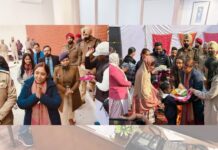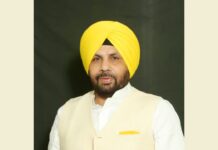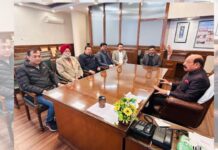‘Apply lessons from past waves of the pandemic; Follow ‘Dharma’ of COVID protocol at all times’
VP lauds Indian origin physicians for being ‘ambassadors of Indian value systems’
‘India-US collaboration in health can reap benefits for the entire world’: Vice President
Shri Naidu suggests exploring telehealth and other tech solutions to bridge urban-rural divide in health
VP praises Telangana for excelling in NITI Aayog’s Health Index
Vice President gives inaugural message at 15th Global Health Summit organized by American Association of Physicians of Indian Origin (AAPI)
The Vice President, Shri M. Venkaiah Naidu today called for a sense of urgency in dealing with the new surge in COVID cases and to apply the lessons of the past waves of the pandemic. “We must consider it our ‘Dharma’ and ‘Kartavya’ to follow the COVID protocol at all times – wearing a mask, maintaining physical distancing and getting vaccinated, and secure ourselves and our community”, he emphasized.
Noting the importance of the measure to vaccinate age groups 15-18 years, Shri Naidu urged parents of the children in the newly eligible age groups to get their wards vaccinated at the earliest. He called upon public-minded individuals, social advocacy groups, medical professionals and the government to reach out to as many people as possible and get rid of any vaccine hesitancy that may be stopping India in its collective fight against the pandemic.
In a recorded inaugural message for the 15th Global Health Summit organized by American Association of Physicians of Indian Origin (AAPI), the Vice President praised Indian origin medical professionals for “making their mark in every corner of the world” and being the “personification of our nation’s civilisational value of Vasudhaiva Kutumbakam”.
Shri Naidu observed that in the US in particular, Indian origin physicians have gained a formidable reputation and that several of them occupy the top administrative positions in the country. “They are among the most successful ambassadors of India’s value systems”, he added.
Noting that Indian firms have collaborated with US-based organisations to produce the recently approved vaccines — Corbevax and Covovax, the Vice President said “this experience clearly shows India-US collaboration in healthcare can reap great benefits not only for our countries, but for the entire world”.
In the message, the Vice President expressed concern that while urban areas have technology in tertiary care that attract international patients, it is worrisome that rural areas are lagging behind with limited access to even primary care.
To bridge this, along with other measures, Shri Naidu suggested seriously exploring the use of telehealth and other technological solutions in reaching out better to rural and remote areas. “This will expand the utilisation of our limited manpower and health infrastructure to reach the last mile,” he said.
In this regard, he noted a welcome trend of many health-tech start-ups in India and suggested scaling up their healthcare services for rural areas, so that the geographical barriers may be overcome and out-of-pocket expenditures are rationalized. He observed that Ayushman Bharat Digital Mission, with a digitised record of the patient’s medical history, will boost these efforts.
Shri Naidu lauded the state of Telangana for excelling in the recently released NITI Aayog’s Fourth Edition of State Health Index. He expressed happiness that Telangana is also in the top three states in the year-on-year incremental performance in health outcomes.
The Vice President complimented AAPI for its services in India – for raising $5 million during the second wave of the pandemic, for its ‘Adopt a Village’ programme, among its other initiatives.
Following is the full text of the message:
“Sisters and brothers,
I am indeed very happy to give this inaugural message at the 15th Global Health Summit organised by the American Association of Physicians of Indian Origin (AAPI) today. At the outset, let me congratulate the AAPI for organising this Summit in Hyderabad, with a focus on Preventive, Palliative and Lifestyle medicine and Technology, Telehealth and Transformation.
On this occasion, my hearty congratulations to the state of Telangana which ranks in the top three states in the large states category in NITI Aayog’s Fourth Edition of State Health Index released recently. I am happy to note that Telangana is in the top three states in the year-on-year incremental performance in health outcomes too. My compliments to the state government and all those associated with the health sector for this tremendous achievement.
Sisters and brothers,
Over the past two years, the COVID pandemic has challenged our healthcare systems and has been reinforcing the need to double up our efforts in strengthening our infrastructure. I am happy to see that two new vaccines and an antiviral drug were recently approved by the Government of India to boost the fight against COVID, especially in light of the new variant, Omicron.
With the number of new cases in all the states surging again, it is imperative that we apply the lessons of the past waves of the pandemic with a sense of urgency. We must consider it our ‘Dharma’ to follow the COVID protocol at all times and secure ourselves and our community. We should also encourage those who are unvaccinated in our family to get themselves vaccinated at the earliest.
The Government of India, in a proactive measure, has announced vaccination for the age groups 15-18, along with an additional precautionary dose to those above 60 years of age. These efforts will lend a sharp thrust to India’s fight against COVID.
I urge you today to encourage the parents of the children in the newly eligible age groups to get their wards vaccinated at the earliest. Public-minded individuals, social advocacy groups, medical professionals and the government must reach out to as many people as possible and get rid of any vaccine hesitancy that may be stopping us in our collective fight against the pandemic.
Sisters and brothers,
I am pleased to note that Indian firms collaborated with US-based organisations to produce the two approved vaccines—Corbevax and Covovax. This experience clearly shows India-US collaboration in healthcare can reap great benefits not only for these countries, but for the entire world.
Here, I wish to recall the fact that Indian contribution to global healthcare is not a new phenomenon at all.
Apart from being the ‘pharmacy to the world’ with path-breaking innovations in the pharmaceuticals industry, India, has over the years, become a much sought after ‘medical tourism destination of the world’. Data reveals that nearly 7 lakh foreign tourists came for medical treatment in India in the year 2019 alone.
Indian medical professionals—doctors, nurses and technicians have been making their mark in every corner of the world and have been offering invaluable services for many decades now. It is estimated that there are 1.4 million physicians of Indian origin all over the world.
In the US in particular, many Indian origin physicians have gained a formidable reputation in their respective fields. Several of them occupy the top administrative positions in the medical field in the country, including Dr Vivek Murthy, the present Surgeon-General of the United States, among others.
These Indian-origin physicians are a personification of our nation’s cherished civilisational value of ‘Vasudhaiva Kutumbakam’. They are among the most successful ambassadors of India’s value systems and propagators of our mission to ‘Share and Care’ for all the people of the world, irrespective of their nationalities. We are indeed proud of them and their services.
In this regard, it is noteworthy that AAPI, founded in 1982, is one of the largest groups that represent the interests of more than 80,000 practising Indian-origin physicians in the United States and 40,000 medical students, residents and fellows of Indian origin.
I am happy to know that during the second wave of the Covid-19 pandemic, AAPI members had raised $5 million in a short time to support relief activities including sending life-saving equipment such as oxygen concentrators and ventilators. I am also told that the AAPI team is working on installing oxygen plants in hospitals serving rural India, with some of these units having been commissioned already.
Sisters and brothers,
I particularly commend this initiative because improving the infrastructure for rural healthcare is the pressing need of the hour in our country. While we have cutting edge technology in tertiary care in the urban areas that attract international patients, it is worrisome that rural areas are lagging behind with limited access to even primary care.
In order to bridge the urban-rural divide, I had earlier suggested that we consider making rural service compulsory for government doctors stepping out into the field. I had also suggested that we establish at least one medical college per district, open satellite centres of private hospitals in villages and improve health infrastructure, particularly at the primary level.
In addition to these measures, I believe we must also seriously explore the use of telehealth and other technological solutions in reaching out better to rural and remote areas. This will expand the utilisation of our limited manpower and health infrastructure to reach the last mile.
In this context, we are seeing a welcome trend of many health-tech start-ups in India. They are specialising in the areas of online consultation, ordering medicines online, monitoring chronic conditions, and offering cheap diagnostic services. We must expand and scale up these services for rural areas too, so that the geographical barriers may be overcome and out-of-pocket expenditures are rationalised. The Ayushman Bharat Digital Mission, with a digitised record of the patient’s medical history, will also boost these efforts.
Sisters and brothers,
While technological innovation can definitely ease access, it is not a ready fix to all the shortcomings in public health. There is a dire need to increase public spending in health; for instance, states should increase spending on health to more than 8% of their budget by 2022 (as suggested by the Fifteenth Finance Commission).
I am pleased to note that AAPI has started an ‘Adopt a Village’ pilot programme to provide free health screening camps in villages across five states—Tamil Nadu, Andhra Pradesh, Gujarat, Karnataka and Telangana. I am told they are planning vaccination camps in India with the help of local doctors, to address the issue of vaccine hesitancy. These are commendable initiatives indeed.
Another important initiative of AAPI is the awareness program for CPR (Cardiopulmonary Resuscitation). At a time of increasing share of Non-Communicable Diseases, especially those related to the heart, we need greater awareness among people to apply CPR as a lifesaving first-aid technique and save lives during heart attacks or near drowning. I believe school children, at least at higher secondary level, and in fact, every citizen, must be taught CPR along with other basic aspects of first-aid.
Sisters and brothers,
With numerous initiatives, AAPI has come a long way since its inception and has proved to be beneficial not only to Indian-origin American Physicians, but to Indian healthcare as well.
Finally, dear friends in the medical fraternity, as you seek excellence in human health and well-being, do not forget the power of a kind human touch when treating your patients.
My best wishes to you in all your endeavours.
Thank you all. Namaskar.
Jai Hind.”

 हिंदी
हिंदी






